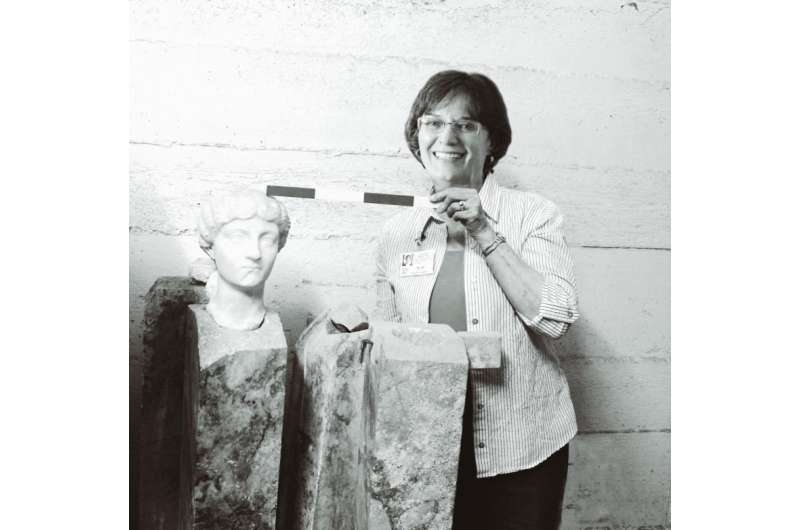Exhibit features luxuries of the wealthy 1 percent of Ancient Rome, new info about Mt. Vesuvius eruption

In AD 79, Mount Vesuvius erupted and wiped out a favorite vacation hotspot of the wealthiest Roman elites.
"Leisure and Luxury in the Age of Nero: The Villas of Oplontis near Pompeii" at the University of Michigan's Kelsey Museum of Archaeology displays the unbridled luxury of one opulent villa and evidence of the uncelebrated slave labor necessary to maintain such extravagance. It provides new information about when the volcanic eruption may have occurred.
The exhibition, which is open to the public until May 15, was curated by Elaine Gazda, professor of classical art and archaeology in the department of the History of Art and curator of Hellenistic and Roman collections at the Kelsey Museum. Gazda worked with the Oplontis Project team that uncovered forgotten artifacts in 2013 that had been placed in storage by Italian archaeologists many years ago.
Q: What parallels exist between the ancient Roman villa owners and the modern cultural idea of the 1 percent?
Gazda: It's heavy-handed to compare it directly to the modern situation, but there were extreme social disparities there—to have a villa like this, you had to have hundreds of slaves just to run it. The exhibition makes it apparent that it wasn't just elites having wonderful banquets with bounty falling from the sky; it was the cooks in the kitchen, the servers, entertainers and farmers who really made it happen. It has a social message, I think, for our own time, without trying to preach. This is not new.
Q: What items were considered luxurious in ancient rome?
Gazda: As just one small example of the luxury of Villa A, we think that it had a saltwater fish tank. Although it could have been used for fish farming, we know that in some cases, such tanks were purely ornamental and stocked with exotic species as a kind of hobby, like a modern aquarium.
Q: Which sites from Oplontis does the exhibition feature?
Gazda: There are two main buildings in our exhibition. The first is a huge luxury building we're calling Villa A, which served as a place to vacation, relax and entertain for Rome's wealthiest people. In fact, it may have been owned by the family of the Roman Emperor Nero's second wife, Poppaea. The exhibition also features a commercial establishment that was found 300 meters down the road, which had apartments and residences as well. At that commercial center, employees and slaves were exporting and importing wine and other goods. This was on a working harbor, now buried under the volcanic debris from the eruption of Mount Vesuvius.
Q: What was the role of slaves at Oplontis?
Gazda: In the villa, slaves had to be everywhere in order to serve their masters, but they also had to stay out of sight as much as possible. In the commercial center, there were probably still slaves, but it may have also had freed slaves or free Romans who were not in the elite class. Nine of the 54 people who were found in the commercial winery, killed by the eruption, were carrying money or jewelry—for some, huge amounts of it. People were trying to escape with their valuables. One theory says that the nine people here were either the elites or their trusted slaves, caring things for the masters.
Q: How has Oplontis changed our ideas about when the eruption of Vesuvius occurred?
Gazda: For a long time, we thought that the eruption happened on Aug. 23 or 24 in AD 79. However, the commercial structure we uncovered here included many empty wine vessels which had been sitting there waiting to be filled. Based on what we know about when grape harvest occurs, we now think that since the vessels were empty, the eruption may have actually happened sometime in November of that year. This actually has implications for a lot of these luxury villas too; if the eruption was in the fall, after the vacation season, the villas may not have been as heavily occupied—and therefore possibly suffered fewer losses of life.
Q: What excites you personally about this exhibition?
Gazda: It was wonderful when I arrived on site in Italy when the pieces had been originally discovered in storage in 2013. Luckily, I arrived in time to help piece a wall painting back together. It's rare for me nowadays to get that thrill of something ancient because I work with ancient things all the time, but it really is a thrill to see this material come to the museum. I'd been working with it on site, and to just see it coming out of these beautifully packed, wonderfully clean crates, it's like I'm discovering them all over again. I hope the audience will feel that sense of thrill, too.
Provided by University of Michigan



















